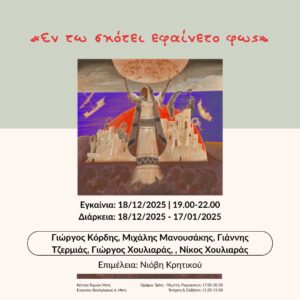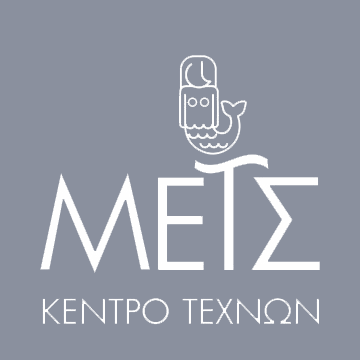«Εν τω σκότει εφαίνετο φως», Διεισδύοντας στον κόσμο του Παπαδιαμάντη
Γιώργος Κόρδης, Μιχάλης Μανουσάκης, Γιάννης Τζερμιάς, Γιώργος Χουλιαράς, Νίκος Χουλιαράς

Εγκαίνια: 18 Δεκεμβρίου και ώρα 19.00 – 22.00
Διάρκεια: 18/12/2025-17/01/2026
Επιμέλεια: Νιόβη Κρητικού
Διεύθυνση: Eυγενίου Βουλγάρεως 6, Μετς, 11636 | Κέντρο Τεχνών Μετς
Είσοδος Ελεύθερη
Η έκθεση «Εν τω σκότει εφαίνετο φως» ανασύρει ως κεντρικό της άξονα τη μυσταγωγία, εκείνη τη λεπτή, υποδόρια ατμόσφαιρα που διατρέχει το σύμπαν του Παπαδιαμάντη και το φορτίζει με μια αίσθηση τελεστικής σκοτεινότητας, ιερότητας και πνευματικής πύκνωσης. Είναι το άρωμα μιας μνήμης που θροΐζει ανάμεσα στο φως και στη σκιά, μιας κατάστασης που κατοικεί στο μεταίχμιο, όπου οι μορφές, οι χειρονομίες και οι ψίθυροι αντηχούν διττά φωτεινοί και σκοτεινοί μαζί.
Το «σκοτεινό φως» που επικαλείται ο τίτλος δεν είναι αντίφαση αλλά μια βαθιά διεργασία αποκάλυψης. Φως που αναδεύει μύθους και παθήματα, που φέρνει στην επιφάνεια την ηθική αβεβαιότητα του ανθρώπου, τις αθέατες πτυχές της ψυχής του και τις ρωγμές όπου ακόμη επιμένει η επιθυμία. Μέσα σε αυτό το πεδίο, όπου η ελληνική γραφή συναντά τη γένεση και το ιερό, οι πέντε καλλιτέχνες προσέρχονται ως ιχνηλάτες της εσωτερικής ανάφλεξης. Αντλούν από το υπόγειο στρώμα της παράδοσης και της κοινής μας μνήμης, μεταπλάθοντας την ύλη τους σε εικόνες που δεν παρατηρούνται απλώς, αλλά βιώνονται. Διανοίγει άδυτες πτυχές και ανασυστήνει το παπαδιαμαντικό τοπίο όχι ως αφήγηση, αλλά ως αισθαντική εμπειρία, μια τελετή φωτός και σκότους που υποβόσκει σαν αθέατο πέπλο, σαν ανάσα που μόλις εκφέρεται, σαν σιγομουρμουριστό μοιρολόι.
Ο Γιώργος Κόρδης, εικονογραφεί τη Φόνισσα, μετατρέπει τον χώρο σε μια σύγχρονη ζωοφόρο, ένα εικονογραφημένο σύμπαν της τραγικής ηρωίδας με σημεία στίξης και αντίστιξης όμοια με αυτά του διηγήματος. Η αφήγηση απλώνεται ως τελετουργικό μονοπάτι ενώ η μορφή της Φραγκογιαννής φωτίζεται και βυθίζεται στη σκιά συγχρόνως. Στο έργο του, η παράδοση της αγιογράφησης, με την ιεροκρατική της βαρύτητα, συγχρωτίζεται με το ηθικό βάρος του παπαδιαμαντικού λόγου. Η εικόνα λειτουργεί ως εξομολόγηση, όπου ο άνθρωπος, στην αναμέτρησή του με το φως, αποκαλύπτεται αμφίρροπος, τρωτός, βαθιά αληθινός. Μια αίσθηση διδαχής απορρέει από το εντυπωσιακό αυτό τέμπλο που δημιουργεί ο Κόρδης, καλώντας μας να συνυπάρξουμε με τους ήρωες του έργου στον ίδιο χωροχρόνο.
Ο Μιχάλης Μανουσάκης, με τη σειρά του, διασχίζει τα μυστικά περάσματα της ύπαρξης· τα έργα του θυμίζουν δωμάτια μνήμης που πάλλονται από ανείπωτα μουρμουρητά, θραύσματα φωτός και σκιές που μετατοπίζονται. «Ακούσµατα απρόσµενων ψιθύρων στα σκασµένα τοιχώµατα των διαδρόµων µε τις διαδροµές του νου για το φως της άλλης διάστασης, αυτής που θα σκαλίζει εσαεί τα όνειρα, τις επιθυµίες και τα πάθη στα άδεια δωµάτια των σωµάτων µε φως πότε ψυχρό, πότε θερµό, νύχτα και µέρα» σημειώνει ο ίδιος, και τα λόγια του φωτίζουν τις αθέατες πτυχές του εαυτού μας. Το πορτρέτο της γυναίκας, αινιγματικό και στέρεο, μετουσιώνει τη γυναίκα-μήτρα, τη μητέρα πάσης φύσεως. Κάτω από το ράγισμα των τοίχων και το υπόγειο φως, η παρουσία της γυναίκας γίνεται φορέας ζωής, πένθους και ονείρου· το υλικό που γίνεται άυλο, το αόρατο που αποκτά σάρκα και οστά.
Ο Γιάννης Τζερμιάς, με τη Μήδεια, συνομιλεί ευθέως με τη Φόνισσα του Κόρδη. Οι δύο μορφές, χωρισμένες από αιώνες αλλά ενωμένες από τη μοίρα τους, φέρουν επάνω τους το ασήκωτο βάρος της παιδοκτονίας. Η Μήδεια και η Φραγκογιαννή συναντιούνται εδώ ως σκοτεινές ιέρειες ενός κόσμου όπου η αγάπη, η οδύνη και το άδικο συμπλέκονται αξεδιάλυτα. Η τραγωδία λειτουργεί ως κοινός τόπος, φορέας μνήμης που ταξιδεύει μέσα στον χρόνο και επανέρχεται ως σύγχρονο εικαστικό ερώτημα. Το βάθος του τραγικού ήρωα ενσαρκώνεται με όρους τελικότητας και σκοπού.
Ο Νίκος Χουλιαράς εισφέρει την ατμόσφαιρα μιας αλλοτινής εποχής με μια εικαστική γραφή πλημμυρισμένη από μυσταγωγία, από ψυχικά τοπία που αναδύονται σαν λαϊκά άσματα και σκιρτήματα του υποσυνείδητου. Το έργο του φέρει κάτι από το νυχτερινό φως των παραμυθιών, από τη γητεία του ελληνικού τοπίου, από τις μυστικές κινήσεις των ταπεινών ανθρώπων και, εντέλει, από εκείνη την υπόγεια ατμόσφαιρα που κατακλύζει τον κόσμο του Έλληνα λογοτέχνη «η κορυφή των κορυφών», όπως τον αποκαλεί ο Κ. Π. Καβάφης.
Ο Γιώργος Χουλιαράς, με τα γλυπτά του, διαρρηγνύει τον χώρο. Οι συμπαγείς όγκοι του μοιάζουν με αρχέγονα ίχνη, απομεινάρια ενός κόσμου όπου η υλικότητα αποκτά τελετουργική, παλμική δύναμη. Σαν οι φόρμες του να προϋπήρχαν σιωπηλές και να αποκαλύπτονται τώρα, για να μιλήσουν για το αιώνιο και το πρωταρχικό, για εκείνη τη μορφή που προηγείται του πράγματος, για την ίδια την ιδέα, τη χροιά και τη σύσταση που θεμελιώνει τα σύμβολα του κόσμου. Και καθώς η σκιά και το φως παλεύουν ανάμεσα στους όγκους, αποκαλύπτεται ξανά αυτή η ιεροφανής ατμόσφαιρα, ένα σκοτεινό φως που φωτίζει την ψυχή, το σώμα και τον μύθο ταυτόχρονα.
Κι καθώς διασχίζει κανείς τις μυσταγωγικές διαδρομές της έκθεσης, ένα μοτίβο φαίνεται να ξεπηδά ξανά και ξανά:
Το φως σώζει ή αποκαλύπτει;
Το σκοτάδι κρύβει ή μαρτυρεί;
Εδώ, «εν τω σκότει εφαίνετο φως» δεν είναι μόνο τίτλος. Είναι ο τρόπος με τον οποίο ο καλλιτέχνης ψηλαφεί τον εαυτό του, μέσα στον πολιτισμό και την εντοπιότητα. Ένα εσωτερικό φως, αμφίσημο και παλλόμενο, που αποκαλύπτει τις αθέατες ποιότητες από τις οποίες συγκροτείται. Ένα φως που συνδέει σημεία της κοινής μνήμης με τον τόπο και το παρελθόν.
Νιόβη Κρητικού
ΕΝ
“In the Darkness Shone a Light”: Penetrating the World of Papadiamantis
Giorgos Kordis, Michalis Manousakis, Giannis Tzermias, Giorgos Houliaras, Nikos Houliaras
Opening: December 18, 7:00–10:00 pm
Duration: 18/12/2025–17/01/2026
Curated by: Niovi Kritikou
Address: 6 Evgeniou Voulgareos St., Mets, 11636 | Mets Arts Center
Free Admission
The exhibition “In the Darkness Shone a Light” brings to the fore, as its central axis, mystagogy—that subtle, subterranean atmosphere that permeates the universe of Alexandros Papadiamantis, charging it with a sense of ritual darkness, sacredness, and spiritual density. It is the scent of a memory that rustles between light and shadow, a condition dwelling in the threshold, where forms, gestures, and whispers resonate dually—luminous and dark at once.
The “dark light” invoked by the title is not a contradiction, but a profound process of revelation. A light that stirs myths and afflictions, that brings to the surface the human being’s moral uncertainty, the unseen folds of the soul, and the fissures where desire still persists. Within this field—where Greek writing encounters genesis and the sacred—the five artists appear as trackers of inner ignition. Drawing from the underground strata of tradition and our shared memory, they transmute their material into images that are not merely observed, but experienced. The exhibition opens sealed-off dimensions and reconstitutes the Papadiamantic landscape not as narrative, but as a sensory experience: a rite of light and darkness that underlies everything like an unseen veil, like a breath barely uttered, like a softly murmured lament.
Giorgos Kordis illustrates The Murderess, transforming the space into a contemporary frieze—an iconographic universe of the tragic heroine, punctuated by pauses and counterpoints akin to those of the short story itself. The narrative unfolds as a ritual path, while the figure of Fragkogiannou is illuminated and submerged in shadow simultaneously. In his work, the tradition of icon painting, with its hieratic gravity, intertwines with the moral weight of Papadiamantis’ prose. The image functions as a confession, where the human being, in confronting the light, is revealed as ambivalent, vulnerable, and profoundly truthful. A sense of didactic resonance emanates from this impressive templon created by Kordis, inviting us to coexist with the protagonists of the work within the same space-time continuum.
Michalis Manousakis, in turn, traverses the secret passages of existence. His works resemble rooms of memory pulsating with unspoken murmurs, fragments of light, and shifting shadows. “Echoes of unexpected whispers on the cracked walls of corridors, with the pathways of the mind toward the light of another dimension—one that will forever engrave dreams, desires, and passions in the empty rooms of bodies, with light sometimes cold, sometimes warm, night and day,” he notes, and his words illuminate the unseen aspects of ourselves. The portrait of the woman—enigmatic and grounded—transfigures her into woman-as-womb, the mother of all nature. Beneath the fissures of walls and the subterranean light, her presence becomes a bearer of life, mourning, and dream: matter rendered immaterial, the invisible acquiring flesh and bone.
Giannis Tzermias, with Medea, enters into direct dialogue with Kordis’ Murderess. The two figures, separated by centuries yet united by fate, bear the unbearable weight of infanticide. Medea and Fragkogiannou meet here as dark priestesses of a world where love, anguish, and injustice are inextricably entwined. Tragedy functions as a shared locus, a carrier of memory traveling through time and returning as a contemporary visual inquiry. The depth of the tragic hero is embodied in terms of finality and purpose.
Nikos Houliaras contributes the atmosphere of a bygone era through a visual language imbued with mystagogy, with psychic landscapes that emerge like folk songs and stirrings of the subconscious. His work carries something of the nocturnal light of fairy tales, of the allure of the Greek landscape, of the secret movements of humble people, and ultimately of that subterranean atmosphere that saturates the world of the Greek writer—“the summit of summits,” as C. P. Cavafy calls him.
Giorgos Houliaras, through his sculptures, ruptures space. His compact volumes resemble primordial traces, remnants of a world where materiality acquires ritualistic, pulsating power. As if his forms had preexisted in silence and are now revealed to speak of the eternal and the primordial—of that form which precedes the thing, of the very idea, hue, and substance that ground the symbols of the world. And as shadow and light struggle among the volumes, this hierophanic atmosphere is once again unveiled: a dark light that illuminates soul, body, and myth simultaneously.
As one traverses the mystagogical paths of the exhibition, a motif seems to surface again and again:
Does light save, or does it reveal?
Does darkness conceal, or does it testify?
Here, “in the darkness shone a light” is not merely a title. It is the way in which the artist gropes toward the self, within culture and locality. An inner light—ambiguous and pulsating—that reveals the unseen qualities from which one is constituted. A light that connects fragments of collective memory with place and with the past.
Niovi Kritikou

